Gymnodoris citrina
(Bergh, 1875)
Order: NUDIBRANCHIA
Suborder: DORIDINA
Family: Gymnodorididae
DISTRIBUTION
Widespread in Indo-West Pacific
Reference:
• Bergh, L.S.R. (1875). Malacologische Untersuchungen. In: C.G. Semper, Reisen im Archipel der Philippinen, Wissenschaftliche Resultate. Band 2, Heft 8: 315-344, Pls. 40-45.
Rudman, W.B., 1999 (March 11) Gymnodoris citrina (Bergh, 1875). [In] Sea Slug Forum. Australian Museum, Sydney. Available from http://www.seaslugforum.net/find/gymncitr
Related messages
Cannibalism in Gymnodoris citrina
February 23, 2000
From: Scott Johnson
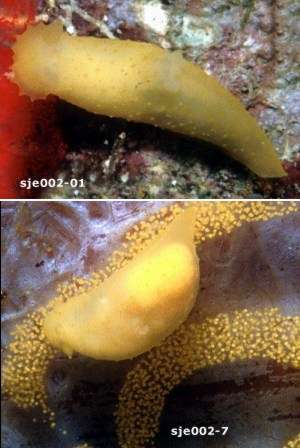
Hi Bill,
I wrote some of the following for the Hawaiian Shell News a few years ago, but I welcome the opportunity to share a few more color photos.
It's interesting that my earlier sent gymnodorids (E139 and E005, listed as Gymnodoris sp. 3 in the Forum) are so similar internally to Gymnodoris citrina, which external characters seem to tell us are obviously different. Another difference is habitat; Gymnodoris sp. 3 were all found on sand, while I always see G. citrina under rocks. While I'm not sure of the diets of Gymnodoris sp. 3, G. citrina eats gymnodorids and their eggs; photo e002-7 shows a G. citrina eating the eggs of G. striata. But they will also cannibalize other G. citrina. At Enewetak, I used to try to keep pairs of various species to try to obtain and examine egg masses. I never found pairs of G. citrina, but they were common enough that I could often find more than one on a single collecting trip. However, every time I tried to collect two of them, I'd invariably make it back to the lab with only one. At first I figured they were the Houdini of nudis, but one day I caught them in the act. When I added a specimen to a bottle that already contained one, the two immediately latched on to each other as in photo E002-02, and one ultimately devoured the other. Startled, I found some more and tried it again several more times. Each time the reaction was the same; they always tried to eat each other, with the larger one usually winning.
Now this would seemingly present a problem. If they eat each other at every opportunity, when do they reproduce? Photos E002-03 through E002-06 have the answer. They copulate while trying to swallow each other. The reproductive organs evert and twist all up, and mating takes place while one of the combatants slowly gains the upper hand and swallows the other. Usually, the last bit of prey left exposed is the reproductive organ. This would still seem disadvantageous to the population, cutting reproductive potential of the species with each meal. But perhaps they do not wander around and encounter each other very often during normal conditions. I have speculated that since populations of some other gymnodorids seem to boom and bust periodically (G. ceylonica, and G. striata sent earlier), perhaps cannibalism is a way to tide individuals of G. citrina over the dry spells when there are few other gymnodorids around to eat.
Scott
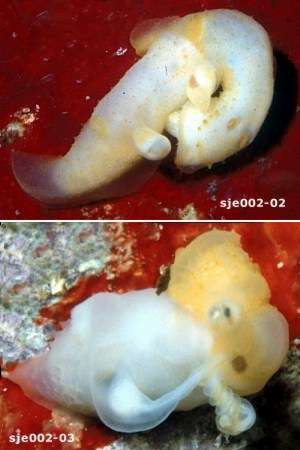
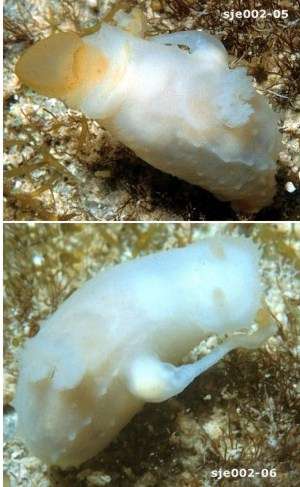
Dear Scott,
Thanks for the amazing series of photos. I am glad you found both yellow and white forms of G. citrina as I found both colour forms in east Africa but have only come across the paler white form in the South Pacific. I also had the cannibalism problem when collecting but have never experienced them eating each other while copulating! That's something I thought only spiders and praying mantids got up to.
Best wishes,
Bill Rudman.
Gymnodoris citrina from Samoa
February 12, 2000
From: Don Barclay
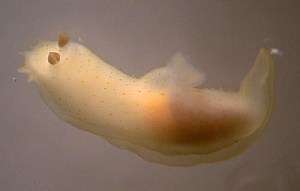
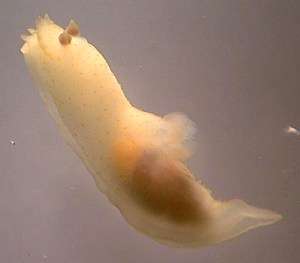
Hi Bill,
A few nights ago (31 Jan 2000) I went back to the location where I had found the little red bubble shell to see if I could find another one. The moon was dark and the tide low, and lots of different molluscs were stirring, but nothing that looked like a Bullina. I found several Mitra species that are uncommon in Samoa, plus this little nudibranch. It isn't pictured in either of the books that I have, and I've been through most of the possibilites on your site without finding it. If it is something so common that it's not worth listing, please just trash this post. Otherwise, I would be interested in the ID. This is one that I haven't seen before, and it came from the west side of Pago Pago Harbor, Utulei village, in about two meters of water where it was crawling up the side of a boulder encrusted with Halimeda patches and scattered coral growths. When it is stretched out crawling, it measures approximately 25mm. As the photos mostly show, it is nearly transparent, cream colored with small orange dots, and the sides of the foot are tinted pale green.
Thanks,
Don
Pago Pago,
American Samoa
n5ols@samoatelco.com
Barclay, D., 2000 (Feb 12) Gymnodoris citrina from Samoa. [Message in] Sea Slug Forum. Australian Museum, Sydney. Available from http://www.seaslugforum.net/find/1867Dear Don,
Your nudibranch is Gymnodoris citrina. It is one of a family of hunting nudibranchs which feed on other sea slugs, each species having a fairly particular group of species that they prefer to eat. One reason I haven't many species displayed on the Forum is that I am in the process of preparing a scientific revision of the genus, and I thought it would be easier to wait until I have the story straight. Gymnodoris citrina is found throughout the tropical Indo-West Pacific and is often found on sandy grass-beds as you describe for your animal.
I'm glad to hear you are out hunting for Bullina.
Best wishes,
Bill Rudman.
Gymnodoris? from Port Stephens
March 11, 1999
From: Carol Buchanan
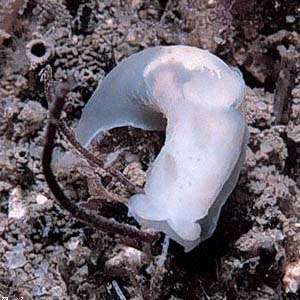
Hi Bill
Here is another one of the Port Stephens nudis. It is tiny around 20mm long.
Could you please confirm the ID I have for it.
thanks
Carol
nandcimages@key.net.au
Buchanan, C., 1999 (Mar 11) Gymnodoris? from Port Stephens. [Message in] Sea Slug Forum. Australian Museum, Sydney. Available from http://www.seaslugforum.net/find/655Hi Carol,
It is definitely a species of Gymnodoris. I am pretty sure it is Gymnodoris citrina but there is not enough definition in the photo to be sure. I am at present preparing a paper on the family. With few exceptions, the species of this genus can be described as white with orange spots or lines. They certainly didn't learn about colour from the chromodorids!
When I get that finished I will put up some pictures of different species. The gymnodorid section of the Sea Slug Forum is looking a bit thin at present.
Best wishes,
Bill Rudman
